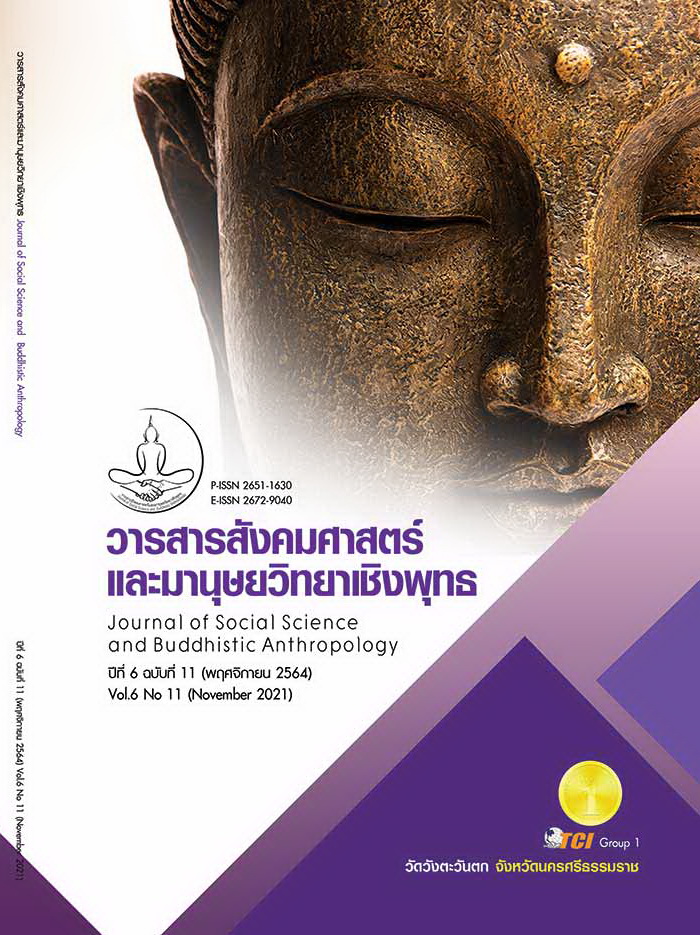A STRUCTURAL EQUATION MODEL OF ADMINISTRATIVE FACTORS AFFECTING THE PREVENTION AND CONTROL OF ANTIMICROBIAL RESISTANCE EFFECTIVENESS IN TERTIARY HOSPITALS
Keywords:
Structural Equation Model, Administrative Factors, Effectiveness of Prevention and Control of Antimicrobial Resistance ProgramAbstract
The objectives of this research article were to study the level of administrative factors and the effectiveness; exam the goodness of fit the model and to explain the path of administrative factors affecting the prevention and control of antimicrobial resistance effectiveness. The population was Infection control committee and infection control working groups in 27 tertiary hospitals. 536 samples derived by purposive random sampling. Questionnaire, reliability 0.96. The data was analyzed by descriptive statistics, confirmatory factor analysis and path analysis. The result of research found that administrative factors and the prevention and control of antimicrobial resistance effectiveness were high level. The goodness of fit test the model of administrative factors affecting the prevention and control of antimicrobial resistance effectiveness developed was consistent with the empirical data. (Chi - Square = 202.98 Relative Chi - Square = 1.96 CFI = 1.00 GFI = 0.96 AGFI = 0.93 RMSEA = 0.04 and SRMA = 0.02) Leadership of administrators was has direct influence on organization culture, organization climate, and organization competency with the coefficient of influence 0.57, 0.50, and 0.40, and has indirect influence on the effectiveness of the program with the coefficient of influence 0.43. The organization climate, organization competency and organization culture have indirect influence on the prevention and control of antimicrobial resistance effectiveness, with the coefficient of influence 0.47, 0.26, and 0.15. All variables in the influence path model were predicted the effectiveness of the program on prevention and control of antimicrobial resistance by 87%. Enhancing administrators’ leadership should be done to affect organization climate, organization competency, and organization culture, in order to improve the effectiveness of the prevention and control of antimicrobial resistance program.
References
เกวลิน ชื่นเจริญสุข และคณะ. (2562). 6th Service Plan Sharing: ผลการดำเนินการขับเคลื่อน Service plan. กองบริหารการสาธารณสุข สำนักงานปลัดกระทรวงสาธารณสุข. เรียกใช้เมื่อ 20 ธันวาคม 2563 จาก http://203.157.3.56/APP/SERVICEPLAN/uploads/allebook/index.html#p=51
คณะกรรมการประสานและบูรณาการงานด้านการดื้อยาต้านจุลชีพ. (2560). แผนยุทธศาสตร์การจัดการการดื้อยาต้านจุลชีพประเทศไทย พ.ศ.2560 - 2564. เรียกใช้เมื่อ 5 ธันวาคม 2561 จาก http://www.fda.moph.go.th/sites/drug/Shared%20Documents/AMR/01.pdf
จิรประภา เกิดชา และนิตยา เงินประเสริฐศรี. (2561). การรับรู้ประสิทธฺผลองค์การ: ข้อค้นพบจากกรมอนามัย กระทรวงสาธารณสุข. วารสารสหวิทยาการวิจัย: ฉบับบัณฑิตศึกษา, 7(1), 188-197.
บุญชม ศรีสะอาด. (2553). การวิจัยเบื้องต้น. (พิมพ์ครั้งที่8). กรุงเทพมหานคร: สุวีริยาสาส์น.
บุศรา เข็มทอง. (2560). บทความวิชาการ: แผนยุทธศาสตร์การจัดการการดื้อยาต้านจุลชีพประเทศไทย พ.ศ. 2560 - 2564. สำนักวิชาการ สำนักงานเลขาธิการสภาผู้แทนราษฎร. เรียกใช้เมื่อ 25 กรกฎาคม 2562 จาก https://library2.parliament.go.th/ebook/content-issue/2560/hi2560-004.pdf
พงศธร พอกเพิ่มดี. (2561). แผนยุทธศาสตร์ชาติ ระยะ 20 ปี ด้านสาธารณสุข (พ.ศ.2560 - 2579). (พิมพ์ครั้งที่ 2). นนทบุรี: กองยุทธศาสตร์และแผนงาน สำนักงานปลัดกระทรวงสาธารณสุข กระทรวงสาธารณสุข.
พรกมล บริพัตรโกศล. (2563). ปัจจัยที่สัมพันธ์และผลกระทบของการใช้ยาปฏิชีวนะอย่างไม่สมเหตุผลในผู้ป่วยที่ติดเชื้อแบคทีเรียแกรมลบในกระแสเลือด. ลำปางเวชสาร, 41(2), 84-95.
ไพศาล ไกรรัตน์ และคณะ. (2561). ตัวแบบความสัมพันธ์เชิงสาเหตุของปัจจัยที่ส่งผลต่อประสิทธิผลการพัฒนาระบบบริการอนามัยสิ่งแวดล้อมขององค์กรปกครองส่วนท้องถิ่นในภาคตะวันออกเฉียงเหนือของประเทศไทย. วารสารชุมชนวิจัย, 12(3),185-199.
วิรัช ประวันเตา และคณะ. (2562). การพัฒนารูปแบบองค์กรที่มีสมรรถนะสูงในการป้องกันควบคุมโรคและภัยสุขภาพระดับจังหวัด. วารสารวิชาการสาธารณสุข, 28(2), S172-184.
วิษณุ ธรรมลิขิตกุล. (2555). การดื้อยาต้านจุลชีพ: ความสำคัญต่อระบบสุขภาพและแนวทางการควบคุมและป้องกัน. วารสารวิจัยระบบสาธารณสุข, 6(3), 300-305.
ศิรภัสสร มูลสาร และคณะ. (2564). ปัจจัยการบริหารและกระบวนการบริหารที่มีผลต่อการปฏิบัติงานของแพทย์แผนไทยในโรงพยาบาลสงเสริมสุขภาพตำบล เขตสุขภาพที่ 10. วารสารวิชาการสาธารณสุข, 7(1), 74-86.
ศูนย์เฝ้าระวังเชื้อดื้อยาต้านจุลชีพแห่งชาติ (NARST). (2561). สถานการณ์เชื้อดื้อยาต้านจุลชีพ 2000 - 2018 สถาบันวิจัยวิทยาศาสตร์สาธารณสุข กรมวิทยาศาสตร์การแพทย์. เรียกใช้เมื่อ 9 เดือนธันวาคม 2561 จาก http://narst.dmsc.moph.go.th/data/AMR%202000-2018-12M.pdf
สุนิสา ธิปัตย์ และคณะ. (2563). ปัจจัยเชิงสาเหตุที่ส่งผลต่อการเป็นองค์กรสมรรถนะสูงของกรมแพทย์ทหารบก. วารสารสถาบันวิชาการป้องกันประเทศ, 11(2), 103-118.
สุภมาส อังศุโชติ และคณะ. (2557). สถิติวิเคราะห์สำหรับการวิจัยทางสังคมศาสตร์และพฤติกรรมศาสตร์: เทคนิคการใช้โปรแกรม LISREL. (พิมพ์ครั้งที่ 4 ฉบับปรับปรุง). กรุงเทพมหานคร: เจริญดีมั่นคงการพิมพ์.
Baral, R. (2015). Organizational Culture and its Implications on Infection Prevention and Control. Journal of Pathology of Nepal, 5(10), 865-868.
Chen, P. I. et al. (2021). Multi - Drug Resistant Organisms Infection Impact on Patients Length of Stay in Respiratory Care Ward. Antibiotics. Retrieved July 22, 2021, จาก https://www.ncbi.nlm.nih.gov/pmc/articles/PMC8160736/
Frieden, T. R. (2014). Six Components Necessary for Effective Public Health Program Implementation. American Journal of Public Health, 104(1), 17-22.
Gulick, L. & Urwick , L. (1973). The Science of Administration. New York: Columbia University.
Hair, J. F. et al. (2010). Multivariate Data Analysis. (7th ed.). New York: Pearson.
Henig, O. et al. (2020). The Impact of Multidrug - Resistant Organisms on Outcomes in Patients With Diabetic Foot Infections. Retrieved July 22, 2021, from https://academic.oup.com/ofid/article/7/5/ofaa161/5831399
O’Neill, J. (2014). Review on antimicrobial resistance. Antimicrobial resistance: Tackling a crisis for the health and wealth of nations. London: Wellcome trust.
Peters. J. T. & Waterman, H. R. (1980). Search of excellence: Lessons from America’s. New York: John Willey.
Valaitis, R. et al. (2018). Organizational factors influencing successful primary care and public health collaboration. BMC Health Services Research, 18(420), 1-17.
Weihrich, H. & Koontz, H. (1993). Management, A Global Perspective. New York: McGraw - Hill.
World Health Organization. (2014). Antimicrobial resistance: global report on surveillance. Retrieved January 3, 2019, from https://apps.who.int/iris/bitstream/handle/10665/112642/9789241564748_eng.pdf
World Health Organization. (2018). Antimicrobial resistance. Fact Sheets. Retrieved May 19, 2019, from https://www.who.int/en/news-room/fact-sheets/detail/antimicrobial-resistance








